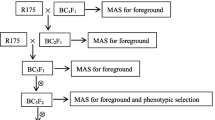Abstract
The CNA-IRAT 5 upland rice population has been improved for 4 years by recurrent selection for blast resistance in Brazil. In order to predict the efficiency of recurrent selection in different test systems and to compare the relative advantage of hybrids versus pure line breeding, a combined genetic analysis of partial blast resistance in the CNA-IRAT 5 population was undertaken. A three-level hierarchical design in inbreeding and a factorial design were derived from the base population. Partial blast resistance of lines and hybrids was evaluated in the greenhouse and in the field by inoculation with one virulent blast isolate. The means and genetic variances of the hybrids and lines were estimated. Genetic advance by recurrent selection was predicted from estimates of variance components. The inheritance of partial blast resistance was mainly additive but non-additive effects were detected at both levels of means and variances. Mean heterosis ranged from 4%–8% for lesion size and lesion density to 10–12% for leaf and panicle resistance. High dominance or homozygous dominance variances relative to additive variance and negative covariance between additive and homozygous dominance effects were estimated. A low frequency of favourable alleles for partial resistance would explain the observed organisation of genetic variability in the base population. Recurrent selection will efficiently improve partial blast resistance of the CNA-IRAT 5 population. Genetic advance for line or hybrid values was expected to be higher testing doubled haploid lines than S1 lines, or than general combining ability. Two components of partial resistance assessed in the greenhouse, lesion size and lesion density, could be used as indirect selection criteria to improve field resistance. On the whole, hybrid breeding for partial blast resistance appeared to be slightly more advantageous than pure line breeding.
Similar content being viewed by others
References
Bonman JM (1992) Durable resistance to rice blast disease — environmental influences. Euphytica 63:115–123
Cockerham CC (1983) Covariances of relatives from self-fertilization. Crop Sci 23:1177–1180
Cornelius PL, Dudley JW (1976) Genetic variance components and predicted response to selection under selfing and full-sib mating in a maize population. Crop Sci 16:333–339
Dillmann C (1992) Organisation de la variabilité génétique chez les plantes: modélisation des effets d'interaction, conséquences sur la réponse à la sélection. PhD thesis, Institut National Agronomique Paris-Grignon, Paris
Filippi MC, Veillet S, Prabhu AS (1992) Evaluation of recurrent populations for partial resistance to blast in upland rice. Fitopatologia 17:200–201
Gallais A (1974) Covariances between arbitrary relatives with linkage and epistasis in the case of linkage disequilibrium. Biometrics 30:429–446
Gallais A (1977) An experimental check of quantitative genetics on an autotetraploid plant, Medicago sativa L., with special reference to the identity by descent relationship. In: Kremprhane O., Pollack E. (eds) Proc Int Conf Quant Genet. Iowa State University Press, Ames, Iowa, pp 519–540
Gallais A (1984) An analysis of heterosis vs. inbreeding effects with an autotetraploid cross-fertilized plant: Medicago sativa L. Genetics 106:123–137
Gallais A (1990) Application of the concepts of test value and varietal value to the study of genetic advance in recurrent selection: a synthesis. Euphytica 48:197–209
Geiger HH, Heun M (1989) Genetics of quantitative resistance to fungal diseases. Annu Rev Phytopathol 27:317–341
Gillois M (1964) La relation d'identité en génétique. PhD thesis, Faculté des sciences de Paris, Paris
Harris DL (1964) Genotypic covariances between inbred relatives. Genetics 50:1319–1348
Horsfall JG, Barrat RW (1945) An improved grading system for measuring plant diseases (Abstract). Phytopathology 35:655
IRRI (1976) Standard evaluation system for rice. IRRI, Los Banos, Philippines
Notteghem JL (1985) Définition d'une stratégie d'utilisation de la résistance par analyse génétique des relations hôte-parasite. Cas du couple riz-Pyricularia oryzae. Agron Trop 40:129–147
Notteghem JL (1993) Durable resistance to rice blast disease. In: Jacobs T, Parlevliet JE (eds) Durability of disease resistance. Kluwer Academic Publ, Dordrecht, The Netherlands, pp 125–134
Ou SH (1980) Pathogen variability and host resistance in rice blast disease. Annu Rev Phytopathol 18:167–187
Parlevliet JE (1979) Components of resistance that reduce the rate of epidemic development. Annu Rev Phytopathol 70:203–222
Parlevliet JE, Van Ommeren A (1988) Accumulation of partial resistance in barley to barley leaf rust and powdery mildew through recurrent selection against susceptibility. Euphytica 37:261–274
Prabhu AS, Farias JC, Zimmermann FJP (1989a) Comparative yield loss estimates due to blast in some upland rice cultivars. Fitopatologia 14:227–232
Prabhu AS (1989b) Method for evaluating resistance to Pyricularia oryzae in rice. Int Rice Res Newsl 14:18–19
Roumen EC (1993) Partial resistance in rice to blast and how to select for it. PhD thesis, Wageningen Agricultural University, Wageningen, The Netherlands
SAS Institute Inc (1988) SAS/STAT™ user's guide, release 6.03 edn. SAS Institute Inc, Cary, N.C.
Schnell FW, Cockerham CC (1992) Multiplicative vs. arbitrary gene action in heterosis. Genetics 131:461–469
Singh RJ, Ikehashi H (1981) Monogenic male-sterility in rice: induction, identification and inheritance. Crop Sci 21:286–289
Taillebois J, Guimarães EP (1989) CNA-IRAT 5 upland rice population. Int Rice Res Newsl 14:3
Veillet S (1993) Organisation of the genetic variability and recurrent selection in rice (Oryza sativa L.). PhD thesis, Institut National Agronomique Paris-Grignon, Paris
Villareal RL, Nelson RR, MacKenzie DR, Coffman WR (1981) Some components of slow-blasting resistance in rice. Phytopathology 71:608–611
Virmani SS, Edwards IB (1983) Current status and future prospects for breeding hybrid rice and wheat. Adv Agron 36: 145–214
Wang GL, Mackill DJ, Bonman JM, McCouch SR, Champoux MC, Nelson RJ (1994) RFLP mapping of genes conferring complete and partial resistance to blast in a durably resistant cultivar. Genetics 136:1421–1434
Wang Z, Mackill DJ, Bonman JM (1989) Inheritance of partial resistance to blast in indica rice cultivars. Crop Sci 29:848–853
Author information
Authors and Affiliations
Additional information
Communicated by G. S. Khush
Rights and permissions
About this article
Cite this article
Veillet, S., Filippi, M.C. & Gallais, A. Combined genetic analysis of partial blast resistance in an upland rice population and recurrent selection for line and hybrid values. Theoret. Appl. Genetics 92, 644–653 (1996). https://doi.org/10.1007/BF00226084
Received:
Accepted:
Issue Date:
DOI: https://doi.org/10.1007/BF00226084




